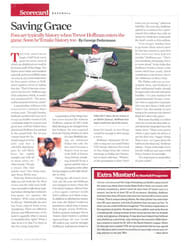
The Tight End: Version 2.0
They had gatheredinside the Kent State Field House on a crisp April afternoon in 2003 for onereason: to judge whether Antonio Gates, the Golden Flashes' All-Conferencebasketball player, had the tools to play professional football. Scouts from theColts, Steelers and 49ers, and the tight ends coaches from the Browns and theChargers took their places on the indoor field as Gates completed hisstretching. Once the workout got under way, however, most were wondering whythey had come. ¶ Gates plodded through his agility drills, showed littleexplosiveness on his routes and looked as if he'd added a few unflatteringpounds to his 6'4", 260-pound frame. After he ran an embarrassing 4.8 inthe 40, the scouts and coaches had seen enough. At the suggestion of TimBrewster, then the Chargers' tight ends coach, they ended the workoutearly.
But as hiscolleagues gathered their belongings and wished Gates the best, Brewsterlingered behind, hoping nobody else knew what he knew: that Gates had sprainedhis right ankle a week earlier playing in the Portsmouth (Va.) Invitational, ashowcase for NBA prospects. For nearly two months Brewster had been in regularcontact with Gates, who five years earlier had gotten a football scholarship toMichigan State. From watching tapes of Gates playing power forward, the coachbelieved he could be a Charles Barkley in shoulder pads.
Brewsteremphasized that potential in his report to the San Diego front office. "IfI had been truthful to the organization about what I saw that day," saysBrewster, now the tight ends coach for the Denver Broncos, "we probablywouldn't have signed Antonio." And all it cost them was a $7,000 signingbonus.
Fast forward tolast November, when Gates pulled his Bentley Continental GT into the lot of theLos Angeles Center Studios for a meeting with Fastbreak Entertainment producerRodney Henry to discuss a documentary of the player's improbable journey to NFLstardom. In less than three seasons Gates had become not only a central figurein the Chargers' rise from laughingstock to AFC contender, but also the face ofa revolution at his position.
There have alwaysbeen athletic, pass-catching tight ends in the NFL-Dave Casper in the 1970s,Ozzie Newsome and Kellen Winslow in the '80s, Shannon Sharpe in the '90s-butnever have there been so many. Look around the league and you'll find swift,athletic tight ends on almost every roster. Tony Gonzalez, a power forward andtight end at Cal, was at the forefront of the new era after he was taken by theKansas City Chiefs in the first round of the '97 draft. Gonzalez would become amajor weapon, averaging 79 catches a season over his last seven years. He wasjoined by a generation of game-breakers at the position, including the AtlantaFalcons' Alge Crumpler, the Baltimore Ravens' Todd Heap and the New YorkGiants' Jeremy Shockey. Too fast for linebackers to cover and too big forsafeties, these players open up space in the passing game and create mismatchesin coverage that offensive coordinators around the league are working toexploit (left).
Indeed, with hissize and speed, the new-breed tight end is arguably the most versatile athleteon the field. (Who can forget the New England Patriots' Ben Watson's sprintingmore than 100 yards to bring down Denver cornerback Champ Bailey on aninterception runback in last year's playoffs?) Speed is so valued at tight endthat Maryland's Vernon Davis vaulted to the sixth pick (by the 49ers) in the2006 draft after his 4.38 in the 40 at the scouting combine. "The new-agetight end is way more athletic and physical," says Steelers linebackerJames Farrior, "and he can really stretch the field. That's what AntonioGates does. He's not a normal tight end."
Gates isn'tphysically imposing, nor does he possess Davis's blazing speed, but what makeshim dangerous is that he can call on so many skills to overcome whateverdefenses devise to stop him. Case in point: Gates's 10 catches for 145 yardsand three touchdowns in a 28-20 victory over the Chiefs last season. On thefirst touchdown pass, a 19-yarder from then Chargers quarterback Drew Brees,Gates juked Chiefs safety Jerome Woods at the line of scrimmage with ahip-and-shoulder fake that resembled a crossover dribble. On his second score,a 20-yarder, he outleaped two defenders in the end zone. And early in thefourth quarter he grabbed a short toss over the middle, broke free from thegrasp of strong safety Sammy Knight and raced into the end zone for a 35-yardscore.
Gates has startedslowly this season-six catches for 81 yards as San Diego has eased Brees'ssuccessor, Philip Rivers, into the offense-but the Chargers plan to maximizehis versatility. They'll be shifting and motioning Gates more than ever, evenhaving him set up in the backfield, then moving to another spot before thesnap. Regardless of where he lines up, he's likely to create a mismatch."Antonio forces teams to put their best cover guy on him," saysChargers left tackle Roman Oben. "He's too big for safeties and too fastfor linebackers. He's talented enough to make a good cornerback lookbad."
There is, ofcourse, room for improvement, particularly in recognizing coverages, but eventhere he has made big strides. "I know what I'm doing now," Gates says."The game is slowing down for me, and now I want to see the field in thesame way Magic Johnson and Larry Bird saw the basketball court. I want to seeplays before they happen."
It's no surprisethat Gates draws an analogy to basketball. It was his favorite sport as achild, and he played it endlessly on the streets of Detroit's west side. Butcoming out of Central High, where he had been a standout in football and hoops,he committed to Michigan State's football program, partly because coach NickSaban promised he could also try out for the basketball team. Then in fall1998, his first semester at the school, Gates, a Prop 48 qualifier who wassitting out the football season, fell behind in the classroom. In late October,Saban rescinded the basketball portion of their deal.
Gates fumed, butSaban still had high hopes for the young man's football career. He even dug outtape of Gates's performances at Central High and told him, "This is whatNFL teams are looking for." But at the end of that semester Gatestransferred to Eastern Michigan, where he played 18 basketball games in the1999-2000 season before he was dismissed from the team for academic reasons. Hethen bounced from the College of the Sequoias, a junior college in Visalia,Calif., to Henry Ford Community College in Dearborn, Mich., before landing atKent State for his junior and senior seasons. Though undersized, he became atwo-time All-Mid-America Conference power forward. Yet by the end of his senioryear, in 2003, he realized there wasn't much of a future in the NBA for6'4" power forwards. And he knew that NFL scouts, still mindful of hisearlier football promise, had been coming to his games to check him out.
Though he hadn'tplayed football since high school, he fit the prototype established byGonzalez: a wide frame, quick feet, exceptional body control, reliable handsand good instincts. Also, while playing college basketball, he had developedskills that proved to be valuable on the football field. From battling forrebounds against players several inches taller, he had learned how to use hisbody to hold off opponents. From making cuts off screens, he had discovered howto create the best angles for receiving passes. And because Kent State coacheshad given him the freedom to create his own shot on the perimeter, he haddeveloped one-on-one moves that were just as effective in the secondary."It became clear real fast that he was going to make the team," saysChargers coach Marty Schottenheimer of Gates's first summer. "You can'tfind that type of athleticism in men his size."
His productionjumped from 24 catches and two touchdowns as a rookie to 81 receptions and 13TDs (the latter is an NFL record for tight ends) in 2004. By last season-whenGates had 89 catches, 1,101 yards and 10 scores-opponents had grown so wary ofhim that in one game Gates found two cover guys hovering around him on a playin which his assignment was pass blocking. Such attention opened up a San Diegooffense that averaged 26.1 points.
despite the lossof Brees, who signed a free-agent deal with the Saints last March, Gatesbelieves he'll continue to enjoy success thanks to the strong bond he has builtwith Rivers. He spent much of his off-season working out with Rivers,fine-tuning patterns and hanging out at the quarterback's home. "He's morepatient when he runs routes," Rivers says. "You can see he trusts theplays more because he's not trying to force anything. Plus, he knows that evenwhen he's double-covered, he's still open in my mind."
That evolution iswhat made Gates the top player at his position in so short a time-and increasedhis Q rating. In the spring he attended autograph signings around the countrywith other NFL stars such as Chicago Bears linebacker Brian Urlacher andCincinnati Bengals wide receiver Chad Johnson and was surprised that so manyfans recognized him in New York, Houston and Chicago. "You never hearpeople say they come to the game to watch the tight end," Gates says,"but I want to be that guy. I want to be known as the most exciting tightend to ever play this game."
THE LIST
For a photo gallery of the top 10 NFL tight ends ofall time, go to SI.com/NFL.
"The new-age tight end is way more ATHLETIC ANDPHYSICAL," says Farrior, "and he stretches the field. That's whatAntonio Gates does."
TWO PHOTOS
PETER READ MILLER;
Photograph by John W. McDonough
TOWER OF POWER San Diego took a $7,000 flier on Gates, who in two years went from all-conference power forward to All-Pro Charger.
THREE PHOTOS
BOB ROSATO (HEAP); SIMON BRUTY (CRUMPLER); PETER READ MILLER (DAVIS)
HEAP OF TALENT A record 12 tight ends, including Heap (86) and Crumpler (83), caught 55 or more passes in '05; expect rookie Davis (85) to be as prolific.

